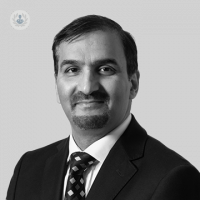Understanding abdominal aortic aneurysms
Autore:In his latest online article, Mr S. Tawqeer Rashid gives us his insights into abdominal aortic aneurysms. He talks about the most common risk factors, the key symptoms, the role of genetic predisposition and the potential long-term complications of an abdominal aortic aneurysm.

What are the most common risk factors associated with a bdominala Ortica neurysm?
When it comes to abdominal aortic aneurysms, the most common risk factor is advancing age. As individuals grow older, their likelihood of developing this condition increases. Primarily, it affects those over the age of 65, especially those over 70. Another significant risk factor is being male. Men have a substantially higher risk, approximately five times greater, compared to women. Another common risk factor is smoking; it roughly triples the risk of developing abdominal aortic aneurysms. Although less common, a strong family history of aortic aneurysms can significantly elevate your risk.
Additionally, untreated high blood pressure over an extended period can also increase the likelihood of developing an abdominal aortic aneurysm. Other factors associated with the condition include typical issues seen in arterial diseases, such as an unhealthy diet, obesity, and, occasionally, diseases affecting other blood vessels. For instance, developing an aneurysm in your leg arteries can be another risk factor for abdominal aortic aneurysms. Furthermore, the presence of general atherosclerotic diseases, ischemic heart disease, and strokes may also contribute to this risk.
What would be the key symptoms that patients should be aware when it comes to aneurysms?
One of the challenges with abdominal aortic aneurysms is that, in the vast majority of cases, it remains asymptomatic. In the past, it was often referred to as the "silent killer" because it typically goes unnoticed until it reaches an advanced stage. Occasionally, symptoms may manifest as pressure-related issues. For instance, it might exert pressure on nerves or nearby structures, leading to symptoms like pain, especially in the back. These symptoms often prompt individuals to undergo a diagnostic scan, but this typically occurs only when the aneurysm has grown considerably in size.
More frequently, abdominal aortic aneurysms are discovered incidentally during scans for unrelated health concerns, such as urological or gastrointestinal issues. On rare occasions, a skilled primary care physician might detect it during an abdominal examination when they notice a pulsating mass inside the abdomen, indicative of a pulsatile mass.
Unfortunately, symptoms tend to arise when the condition becomes highly dangerous, such as when it begins to leak or, in the worst-case scenario, ruptures. At this stage, individuals may experience severe abdominal or back pain, often accompanied by fainting or collapse. In such critical situations, the aneurysm is starting to bleed or leak into the abdominal cavity, posing a severe risk to life. In these cases, immediate ambulance transport to a hospital is essential, where surgical intervention for abdominal aortic aneurysm becomes an urgent necessity.
What's the role of genetic predisposition in the development of aortic aneurysm disorders?
Abdominal aortic aneurysms have known genetic associations. If you come from a family with a significant history of abdominal aortic aneurysms, it's advisable to consider early screening, possibly even starting as early as age 50. Specifically, if you have two close relatives, such as a father and an older brother, or a father along with an uncle or grandfather, who have been diagnosed with this condition, it's recommended to undergo abdominal ultrasound scanning at around the age of 50.
What are the potential long-term complications of leaving an untreated aneurysm?
The primary issue with leaving an abdominal aortic aneurysm untreated is its continual growth within the body. Generally, when the aneurysm measures less than approximately five and a half centimetres in the abdominal region, the risk of it rupturing and potentially causing fatality is relatively low, at less than one percent per year. However, as the size exceeds this threshold, much like inflating a balloon, the risk of rupture escalates significantly. For individuals in reasonably good health, we typically recommend intervention once the aneurysm reaches this five-and-a-half-centimetre mark.
When the aneurysm surpasses seven or especially eight centimetres in size, the risk of rupture becomes extremely high. In such cases, we may classify them as very urgent cases or, in certain instances, admit patients to the hospital for inpatient treatment.
Regarding other aneurysms, particularly peripheral artery aneurysms such as those in the legs, there are two primary concerns. The most common type, the popliteal aneurysm, located behind the knee, can release small clots or blockages downstream, leading to a condition called acute ischemia, putting the leg at risk. Without prompt treatment, this can unfortunately result in limb loss. Additionally, although less frequent, these aneurysms can rupture, similar to abdominal aneurysms, causing severe bleeding and posing a small risk of death, along with a significant risk of limb loss.
Mr S. Tawqeer Rashid is a distinguished vascular surgeon with over 25 years of experience. You can schedule an appointment with Mr Rashid on his Top Doctors profile.


